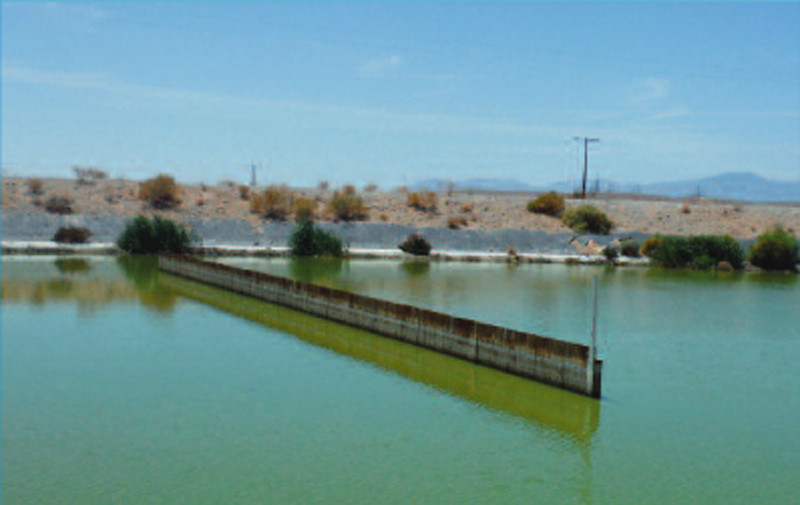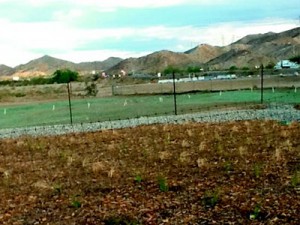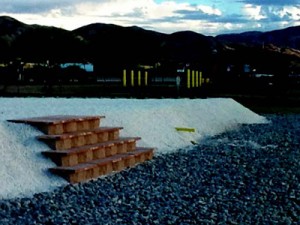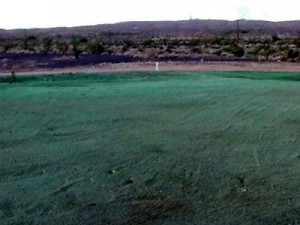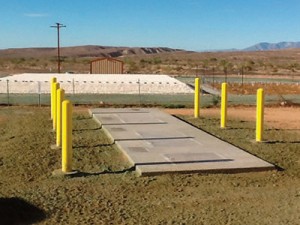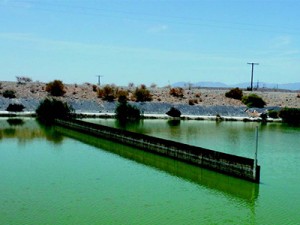PROJECT TYPE: Airport / Transportation
SERVICE: Construction
TECHNOLOGY: Denitrification, Sand Filter
SUSTAINABLE / WATER RE-USE: Sustainable Media / Natural Treatment
LOCATION: Cactus City Rest Area, CA
DESCRIPTION: Construction of the first Anoxic Wetland treatment system at a Caltrans facility; 5,000 gpd sustainable treatment system; Leachfield dispersal system
IWS was the best contractor that Caltrans has ever worked with for an onsite wastewater treatment project.
Anoxic Wetland Treatment System
The innovative Anoxic Wetland treatment system was the central feature of the project and is the first installation of this type of system at a Caltrans facility. Servicing both the East and West bound Safety Roadside Rest Area’s (SRRA), the treatment system has an average flow of 5,000 gpd and peak flow of 10,000 gpd. The existing treatment system comprised of primary treatment followed by aeration in evaporative ponds. The new system is a unique treatment solution promoting sustainability to achieve 21st century advanced treatment performance.
The new treatment system is designed to remove nitrogen and trace organic constituents from wastewater derived from toilet and urinal flushing. SRRA facilities typically have a high concentration of nitrogen and the new system utilizes several mechanisms for nitrogen removal which are intended to evolve over time. In addition, the system has minimal O&M requirements and no chemical addition.
During the first years of operation nitrogen will be removed primarily through conventional heterotrophic denitrification reactions where nitrate produced in the aerobic trickling filter mound will blend with labile organic carbon contained in septic tank effluent. Residual nitrate will be removed in the anoxic treatment wetland through denitrification and plant uptake. The emergent aquatic vegetation plays an important role in replenishing a portion of the organic matter in the bed and improving hydraulic characteristics. Over time it is expected that the bacteria capable of anaerobic oxidation of ammonium (i.e. anammox) type reaction will become established in the anaerobic reaction zone.
The total treatment system area is 7,175 ft2, with a media depth from 3 to 3.5 ft. The treatment system is lined with a high density polyethylene (HDPE) liner. In the treatment system, a limestone nitrification mound is used for nitrogen conversion in a flow from the recirculation tank. Partial denitrification will occur through blending of the nitrified effluent from the recirculation tank with raw septic tank effluent in the inlet zone to the treatment system. The inlet zone media is a clean washed crushed rock. Following the preliminary blending and treatment in the inlet zone, the effluent is treated using a submerged woodchip packed bed filter for denitrification. The reduced loading rate and limestone mound are examples of design features use to maximize nitrification in the wetland.
Leachfield Dispersal
After the wetland treatment system, the treated effluent is then pumped to a leachfield utilizing infiltration chambers (Infiltrator Systems – www.infiltrator.com) and an automatic distribution valve.
Decommissioning Evaporative Pond
In addition to installing the new treatment system, IWS decommissioned the existing evaporative pond. Work included de-watering the sludge in the pond and transporting it to a licensed facility to process. There was an estimated 400 tons of sludge that needed to be processed and disposed of.
Construction Challenges
IWS mobilized to the site in April and completed construction in August, where temperatures reached up to 115 deg F. To accommodate these extreme temperature conditions, IWS started their work day at 4 am and were done by 1 pm. During the course of the project the IWS team was visited by desert deer, rattlesnakes, and large spiders.
Satisfied Client
Caltrans was very satisfied with the quality of IWS work on the project. Jerry Marcotte, PE, the Caltrans Senior Sanitary Engineer commented that “IWS was the best contractor that Caltrans has ever worked with for an onsite wastewater treatment project. IWS was responsive and were very knowledgeable about constructing onsite treatment systems. The system we installed was the first of its kind and we were fortunate to have had IWS install it.”
For more information, please click the ‘Contact’ tab to reach out to us. , .
![]()
download Caltrans Sustainable Treatment System by IWS pdf (610kb)
